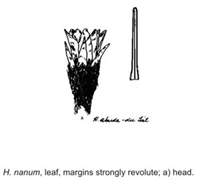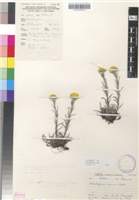Origin of name:
nanus = dwarf
Diagnostic characters:
Bright yellow bractsWeedyLong narrow leavesFlower heads in rounded compact terminal clusters
Description:
A mat-forming perennial herb, main branches stoloniferous, slender (c. 1.5 mm diam.), nude, rooting, producing numerous erect dwarf shoots with closely rosetted leaves, flowering stems terminal to each rosette, solitary, erect, 50-120 mm high, simple or very rarely forked, closely leafy. Leaves stiff, erect, up to 35 mm long, c. 1 mm broad, linear, apex obtuse, base broadened, clasping, margins strongly revolute, both surfaces enveloped in silvery, sericeous, closely felted indumentum. Heads homogamous, cylindric, 4-5 x 1.5 mm, many felted together in small corymbose clusters, these congested, but not felted, in a terminal cymose-corymbose cluster 15-20 mm across. Involucral bracts in c. 2-3 series, subequal, loosely imbricate, outer brownish, inner tipped bright canary-yellow, about equaling flowers, not radiating, translucent. Receptacle smooth. Flowers 4-6, yellow. Achenes c. 1 mm long, obscurely 5-ribbed, glabrous. Pappus bristles c. 5, slender, tips shortly plumose, bases nude, not cohering.
Flowers in March and April, sometimes as late as July.
Distribution:
Forms extensive mats in poor stony grassland or over rock sheets, and will colonize bare eroded areas. Ranges from Harrismith district in the Free State through the foothills of the KwaZulu-Natal and Transkei Drakensberg to the Cape Drakensberg at Naude's Nek, Maclear and Ugie.
Grassland Biome.
Notes:
Leaf bases become woody with age and form persistent nodes on the old stems.
Taxonomy:
Literature:
Helichrysum nanum Klatt in Bull. Herbarium Boissier 4: 461 (1896); Moeser in Bot. Jb. 44: 249 (1910); Hilliard, Compositae in Natal 159 (1977).
Type:
KwaZulu-Natal [Bulwer], Amawahqua [Mtn], Wood 4593 (Z, holo.; BM; K; NH, iso.).
Synonym(s):
Vouchers:
Edwards 3091 (NU; PRE); Hilliard 5520 (E; K; NU; S); Wright 146 (E; NH; NU).


